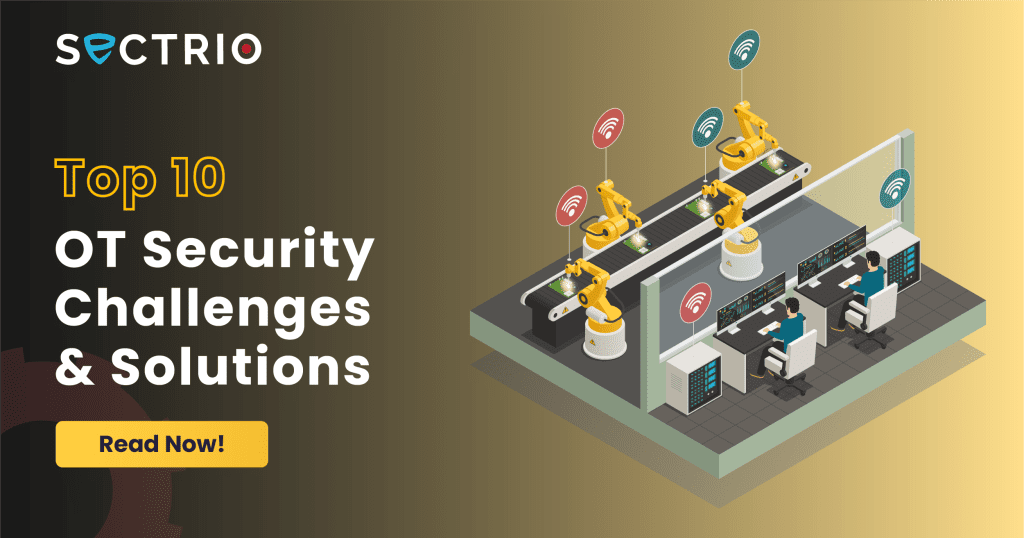OT Security Challenges and Solutions
OT Security – Though the term sounds familiar, global SRM leaders are yet to develop robust OT security solutions for protecting OT networks. Sectrio’s The IoT and OT CISO Peer Survey 2022 highlights that close to 90% CISOs reported one major cyber incident in the last 12 months. Most respondents stated that operations were halted for over four days, incurring losses of over $2.5 Million. The stats mirror the current situation. As if this is not enough, here is another wake-up call. According to a survey, over 30% of critical infrastructure organizations will likely be the victims of OT attacks and threats by 2025. Many point out fingers at the rapid digitization of technologies that propels critical infrastructure. On the same lines, we cannot ignore the fact of the underspending when it comes to establishing and realizing OT security. It took a mammoth effort of countless ransomware attacks, data breaches, and cybersecurity attacks to make us recognize the need for cybersecurity. This transition happened over a decade. Cyber-attacks on IT systems primarily affected individuals and firms, and government organizations. Also read: How to get started with OT security It will not be the same in case of an OT attack. A nation’s security would be at stake if it were a large-scale OT attack. Despite an ever-growing list of OT security vendors, many companies still choose not to opt for OT security solutions. The reason can either be due to budget constraints or failing to acknowledge the consequences of an OT attack. More worrying is that over 80% of the CISOs believe their supply chains are vulnerable to cyber-attacks and OT security attacks. Cyber-attacks on OT networks are an ever-growing concern in the industry. One can minimize exposure to such attacks by following protocols and identifying commonly experienced OT security challenges. This approach will help a CISO and the company’s C-Suite to understand their needs while discussing with various OT Security vendors. Top 10 OT Security Challenges and Solutions: The digitization might have exposed OT networks to more frequent and sophisticated cyber-attacks. But there are other reasons that one needs to understand to address the problem. Subscribing a random OT Security Solutions suite may not protect an OT network entirely. Evaluating the security posture of an OT network prior helps in understanding the kind of security solutions needed. Before addressing the common OT security challenges an OT network might face, it is essential to understand the difference between Challenges and Threats. Challenges are the adversaries that one can address using available resources. Threats are those adversaries that require additional or highlight the lack of resources in a specific domain. The following are the most common OT security challenges on an OT network. To keep you less worried, we also listed the solutions that can help you to handle these challenges. 1. Attrition of Network Architecture Most OT Networks currently existing were designed in the early ’90s and built into the late ’90s, with few in the early 2000s. The security of an OT network work’s on the design philosophy of isolation – completely separated from other networks. This technique ensured default protection of an OT network, irrespective of the advancement of IT-related threats. The OT networks were often guarded by strict protocols at their respective sites, eliminating most threats. The decades-old OT networks need continuous maintenance and installation of upgrades. Rather than periodic and broad-scale upgrades, most manufacturing plants opt for ad-hoc upgrades. This pattern can lead to a gradual attrition of security. Most OT networks’ security architecture follows the Purdue Model of Control Hierarchy – a six-layered, well-defined security protocol. Security erodes with time. One can attribute Ad-hoc updates and those changes made to machinery without considering the impact at a broader level to this. Adding to this, the adoption of ‘wireless communication’ has further worsened the security woes. Despite robust OT security solutions in place, having these vulnerabilities puts the OT network at risk in its entirety. Solution: Managers at manufacturing plants should plan for a complete assessment of the OT network’s security posture ahead of the scheduled updates. It is better to replace obsolete components with new ones on the network than to opt for ad-hoc updates. Trying to extend the lifespan of outdated components through patching and ad-hoc updates weakens the security posture. The cybersecurity team must understand the broad impact of any update before installing it on any device. No one should override the ‘Purdue Model of Control Hierarchy’ or the established set of security protocols to facilitate the installation of any device on a network. As we speak, OT and IT networks are consolidated into a giant complex network. Enterprises should have a comprehensive suite of OT security solutions, preferably from multiple OT Security vendors. 2. Obsolete Machinery and Legacy OS The obsolete machinery and the legacy OS add more weight to a weakening OT network. While obsolete machinery is directly responsible for low productivity, it is solely responsible for ‘incompatibility’ across various systems. Given that every vendor’s software and protocols are proprietary, compatibility across components from different vendors is impossible. Adding to it are the ever-growing cybersecurity concerns. Despite the availability of many OT security vendors, securing obsolete machinery running on legacy OS is impossible. The history of vulnerabilities in Microsoft XP and Windows 7 are well covered. With Microsoft discontinuing the support for these Operating System software, enterprises are left bare in cyberspace, waiting for an attack to occur. These archaic machines and systems do not support modern-day security protocols and have no room for flexibility and scalability. A system crash on this infrastructure results in data loss and a recovery time of hours. If a component fails, this downtime runs into days and even weeks, given the scarce availability of spare parts. High maintenance costs further hit the margins. Knowing that data is the oil of the 21st century, these obsolete machines and legacy OS systems cannot make the most of it. The utilization of data is what decides the fortunes in the present and future. Many enterprises fail to comply with statutory and other regulations by
OT Security Challenges and Solutions Read More »



